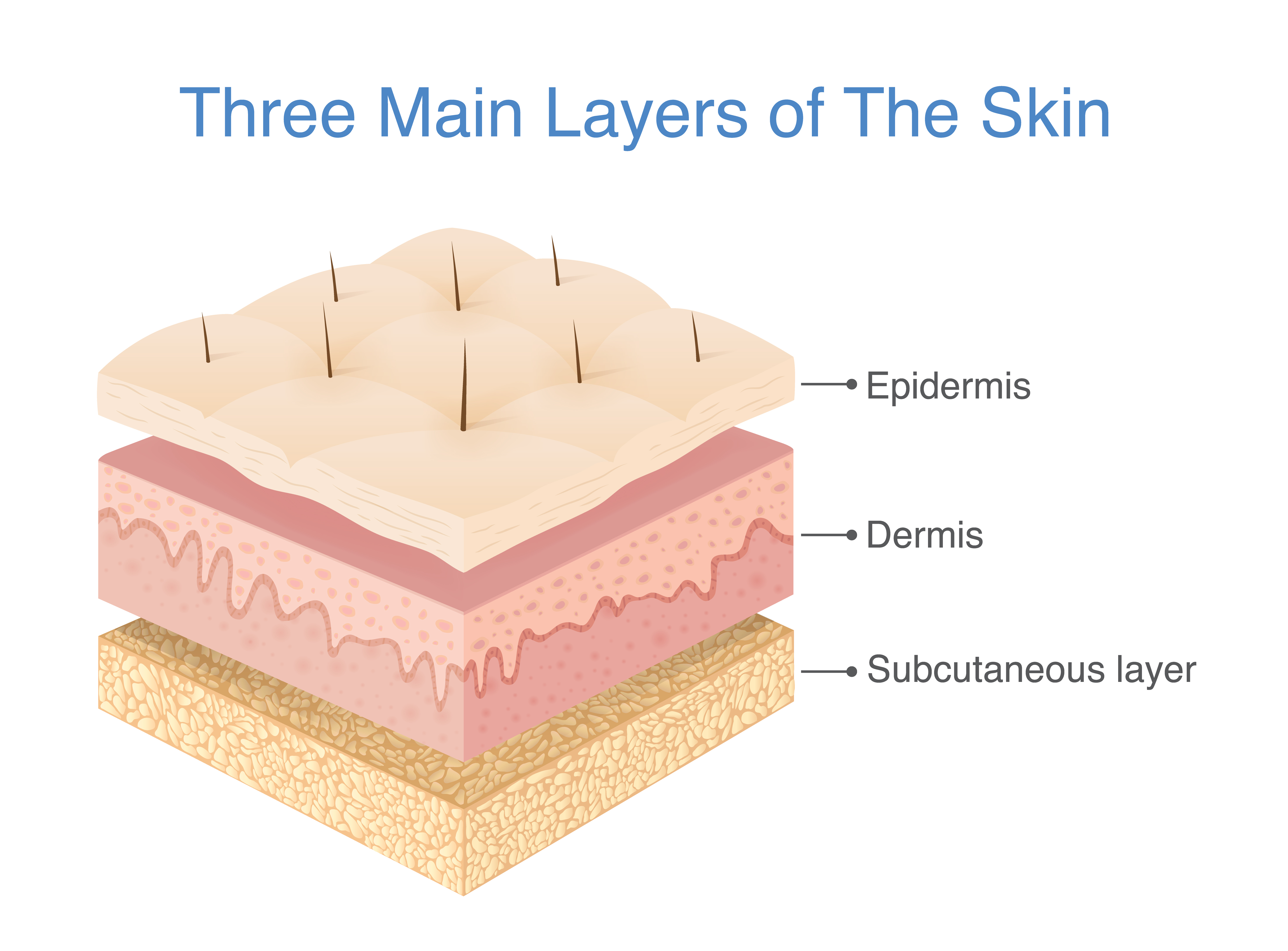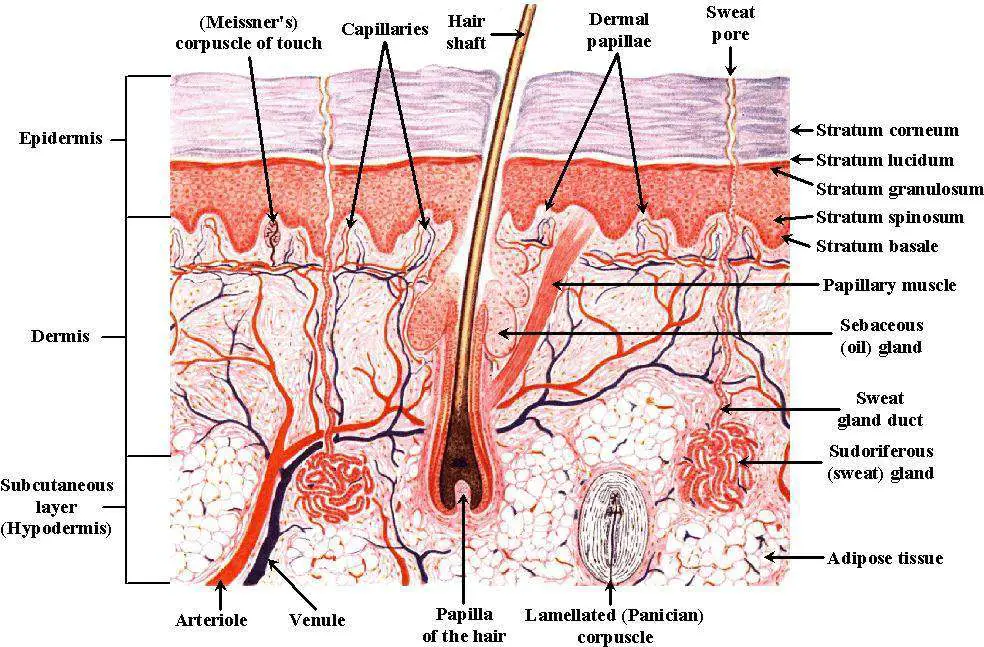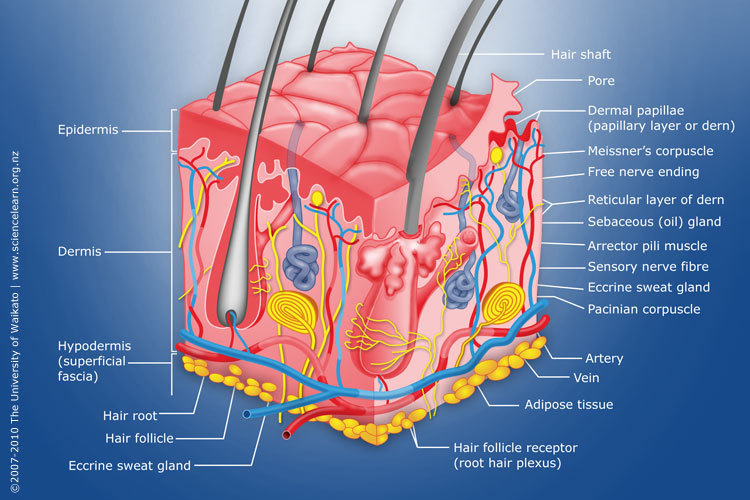Skin diagram to label Labelled diagram
Anatomy of the Skin Skin Facts about the skin The skin is the body's largest organ. It covers the entire body. It serves as a protective shield against heat, light, injury, and infection. The skin also: Regulates body temperature Stores water and fat Is a sensory organ Prevents water loss Prevents entry of bacteria

Some curiosities about the skin Periérgeia
'Skin Diagram || How to draw and label the parts of skin' is demonstrated in this video tutorial step by step.The sense of touch had received supreme importa.

Skin Definition, Structure And Functions Of Skin
Anatomy of the Skin Click Image to Enlarge Facts about the skin The skin is the body's largest organ. It covers the entire body. It serves as a protective shield against heat, light, injury, and infection. The skin also: Regulates body temperature Stores water and fat Is a sensory organ Prevents water loss Prevents entry of bacteria

Dermatology Diagram Show Human Skin Structure Stock Illustration Download Image Now Anatomy
Label the Skin by LegoA1 98,010 plays 11 questions ~30 sec English 11p 54 4.31 (you: not rated) Tries Unlimited [?] Last Played July 31, 2023 - 07:26 PM There is a printable worksheet available for download here so you can take the quiz with pen and paper. Remaining 0 Correct 0 Wrong 0 Press play! 0% 0:00.0 Other Games of Interest Digestive System

What Are The 3 Layers Of Skin? SkinMindBalance
Figure 1. Layers of Skin. The skin is composed of two main layers: the epidermis, made of closely packed epithelial cells, and the dermis, made of dense, irregular connective tissue that houses blood vessels, hair follicles, sweat glands, and other structures.

The structure of the skin is composed of two layers (1) the epidermis... Download Scientific
Your skin includes three layers known as epidermis, dermis, and fat. Some health issues, such as dermatitis and infections, can affect how these different layers work to protect your internal.

Skin Structure infographic LifeMap Discovery
Skin diagram unlabeled Skin anatomy Specialized integumentary system quizzes Sources + Show all Integumentary system quiz and answers One of the best ways to start learning about a new system, organ or region is with a labeled diagram showing you all of the main structures found within it.

Human skin diagram Subcutaneous tissue, Skin structure, Epidermis
Definition Middle layer of the skin; contains collagen; location of sweat & sebaceous glands and nerve endings and capilaries Location Term Epidermis Definition outermost layer of the skin;composed of squamous epithelium; contains keratin Location Term subcutaneous layer Definition

Skin diagram labeled
Figure 5.1.1 - Layers of Skin: The skin is composed of two main layers: the epidermis, made of closely packed epithelial cells, and the dermis, made of dense, irregular connective tissue that houses blood vessels, hair follicles, sweat glands, and other structures.

Structure Of Skin Skin Structure and Function LearnFatafat
Study aids. Related quizzes:. Physiology of the skin, Quiz 1 - Now you know the parts of the skin, learn how they function.; The anatomy of bones, Quiz 1 - Learn the anatomy of a human long bone.; The anatomy of muscle, Quiz 1 - How much do you know about the anatomy of a the different muscle types?; Images and pdf's:. Just in case you get tired of looking at the screen we've provided images.

Anatomy Of Human Skin With Labels Photograph by Hank Grebe Pixels
The Epidermis The epidermis is composed of keratinized, stratified squamous epithelium. It is made of four or five layers of epithelial cells, depending on its location in the body. It does not have any blood vessels within it (i.e., it is avascular). Skin that has four layers of cells is referred to as "thin skin."

loadBinary_006.gif (992×779) Skin anatomy, Integumentary system, Human integumentary system
This article will describe the anatomy and histology of the skin. Undoubtedly, the skin is the largest organ in the human body; literally covering you from head to toe. The organ constitutes almost 8-20% of body mass and has a surface area of approximately 1.6 to 1.8 m2, in an adult. It is comprised of three major layers: epidermis, dermis and.

Dermis Layers, Papillary Layer, Function Epidermis
Functions. The skin has a significant capacity for renewal and crucial roles for the normal functioning of the human body. It is an effective barrier against potential pathogens and protects against mechanical, chemical, osmotic, thermal and ultraviolet radiation damage (through melanin). The skin also takes part in a variety of biochemical synthetic processes, such as vitamin D production.

Skin diagram labeled
Figure 1. The skin is composed of two main layers: the epidermis, made of closely packed epithelial cells, and the dermis, made of dense, irregular connective tissue that houses blood vessels, hair follicles, sweat glands, and other structures. Beneath the dermis lies the hypodermis, which is composed mainly of loose connective and fatty tissues.

Human Anatomy Diagrams To Label koibana.info Skin anatomy, Human anatomy, Anatomy organs
Skin Diagram Labeling . 1. Label the diagram with the . letters. below according to the structure/area they describe. You may label with a line or put the label directly onto the area described. Be as precise as possible. If you are worried about the precision of your label add a word after to explain exactly where your label should be.

Diagram of human skin structure — Science Learning Hub
Dermis. Definition. Fibrous and elastic tissue, provides strength and elasticity to the skin and supports the epidermis, home to hair follicles, glands, nerves etc. Location. Term. Papillary Layer. Definition. Upper dermal layer, provides the epidermis with nutrients and regulates body temperature. Location.